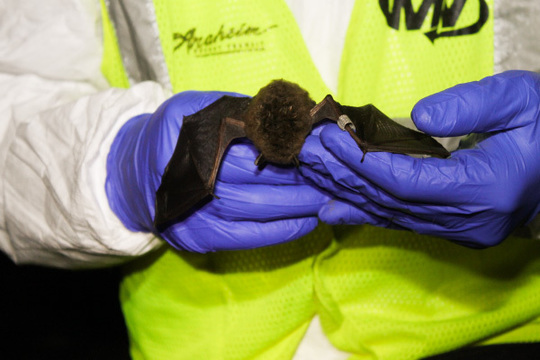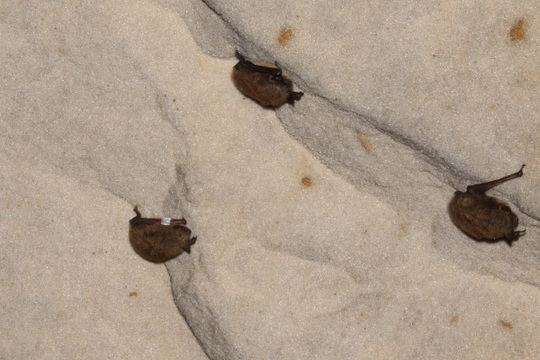Bureau of Natural Heritage Conservation (NHC) staff discover one of the oldest little brown bats ever recorded.

Wisconsin DNR staff read the bat's band number.
About the bat
This male little brown bat was banded in April 1983 making it at least 32 years old in February 2015 when it was last recovered. There is no way to age bats after they reach adulthood (several months after birth), so this bat could have been a yearling born in the summer of 1982, or already several years old in 1983. The bat was banded by Gerda Nordquist and Elmer Birney of the Minnesota DNR in the same site as it was recovered.
What has happened in his lifetime

Over the years, he has eaten a lot of insects
Assuming this bat has eaten its weight (6 grams) in insects every night during its active period for the past 32 years, we estimate it has consumed roughly 13,977,600 mosquito-sized insects.

One of the oldest little brown bats ever recorded hanging with friends. Do you see the silver band?
Other old bats
The record for the oldest little brown bat in the wild is 35 years in Alberta Canada. The bat was banded in 1975 and was recovered as recently as 2009. Little information exists on lifespans of bats in Wisconsin. Other resources indicate most common ages for little brown bats are between six and ten years. Other species in Wisconsin such as the northern long-eared bat have slightly shorter lifespans and the oldest recorded northern long-eared bat was 18 years old.
Of note, the oldest bat on record is a Brandt’s myotis who was last recovered in Siberia at the age of 41.
Small mammal = short life?
Bats have some of the longest life spans when compared to other mammals their size. It is not uncommon for little brown bats to live over 25 years. Other species of bat live up to 20 years. The little brown bat is about the size of a house mouse, which in comparison lives only one to two years on average. Mice also give birth to large litters of four to fourteen young, whereas bats usually give birth to only a single young a year, called a pup.
Why we band bats
Banding is a safe, permanent method of marking individual bats in the wild. Marking individuals allows researchers to gather valuable information about movement and migration, fidelity to sites (returning to the same site year after year), and longevity as in the case of this bat. Much remains to be learned about bats, and following individuals allows us to create a complete picture of bat ecology.

Get a FREE subscription to the Wisconsin Natural Resources Magazine!
Donate $25 to the Bureau of Natural Heritage Conservation and receive a year subscription to the Natural Resources magazine as a thank-you gift.
|
|